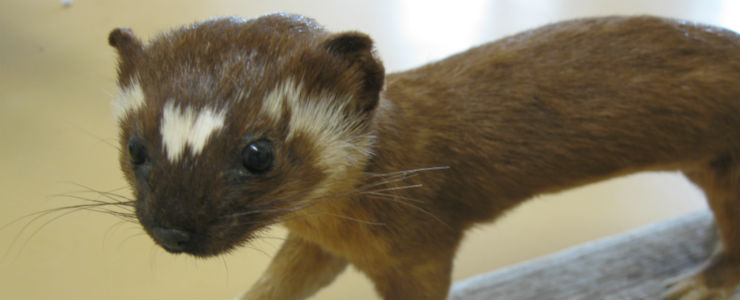Monotremes, Marsupials, and Placentals
The Norris Center houses a collection of approximately 900 mammal study skins, many with corresponding skulls, focusing on mammals of the California Central Coast and rodents of the Western United States. The collection is appropriate to support classes in vertebrate evolution and mammalogy. Currently, the museum is supporting undergraduate research on small mammal populations on the Forest Ecology Research Plot located on upper campus.
Class: Mammalia
The Mammalia class is made up of 5000 species of vertebrates. The main difference between mammals and other vertebrates are three characteristics: hair, milk production in mammary glands, and three bones in the inner ear. Extant mammals are divided into three subclasses based on reproductive techniques (monotremes, marsupials, and placentals) consisting of 27 orders. Within each order, families are organized by taxonomic relationship and distinguished by their genus and species.
Infraclass: Monotremes
Monotremes are made up of only five species: the platypus and four species of echidna. They are egg-laying mammals who are strictly found in Australia and New Guinea. The key anatomical characteristic that distinguishes monotremes from other mammals is that they have a single orifice for urination, defecation, and reproduction. Like all other mammals, monotremes lactate, but lack nipples; excreting milk from mammary glands via opening of the skin. There are no monotremes found here in California.
Infraclass: Marsupials
Marsupial mammals are endemic to Australasia and the Americas and consist of more than 300 species. The primary derived characteristic that distinguishes them from placentals is that they give birth to underdeveloped embryos that innately climb into the mother’s pouch. The most common marsupials are kangaroos, koalas, oppossums, and wombats. The only marsupial found in California is the opposum.
Infraclass: Placentals
Placental mammals are the most diverse group of mammals with about 4000 discovered species. The primary derived characteristic that distinguishes them from other mammals is that the mothers carry the fetus in their uterus where it is nourished via the placenta. Being the most diverse subclass of mammals, it includes all the mammals we are most familiar here in California with: dogs, cats, rodents, elephants, whales, cattle, pigs, humans, etc.
Order: Lipotyphla - Insectivores
Order: Lagomorpha - Rabbits, Hares, and Pikas
Order: Carnivora - Carnivorans
Order: Artiodactyla - Even-toed Ungulates and Cetaceans

